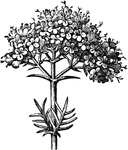Clipart tagged: ‘valerian’

Valerian
Valerian, the type genus of Valerianaceae; an order of herbs. It is distinguished by opposite leaves…

Valerian
"Valerian is an order of herbs or rarely shrubs belonging to the division of monopetalous dicotyledons…

Valerian
"Valeriana celtica. 1. entire flower magnified; 2. the ovary and young calyx; 3. the fruit, with the…

Valerian
Valerian (Valeriana officinalis, Valerianaceae) is a hardy perennial flowering plant, with heads of…

Valerian Flower
Valerian is a hardy perennial flowering plant, with heads of sweetly scented pink or white flowers.…

Valerian Flower (Longitudinal Section)
An illustration of a longitudinal sectional view of the valerian flower. Valerian is a hardy perennial…

Valerian Inflorescence
Valerian is a hardy perennial flowering plant, with heads of sweetly scented pink or white flowers.…

Valerian Seed with Pappus
An illustration of the valerian seed with attached pappus. In a composite flower, Pappus is the part…